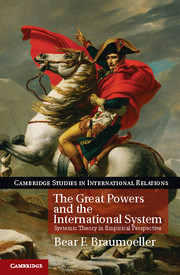Book contents
Appendix B - Empirical details
Published online by Cambridge University Press: 05 January 2013
Summary
Nested politics and structural change
Having elaborated the theoretical model, we can now address the central question: the extent to which the dynamic model of nested politics and structural change maps to the real world in the three systems under consideration. Here, I focus on the more technical aspects of the investigation: ascertaining the probability that the data could plausibly be the product of random chance, as well as examining the correlations among the error terms of the actor-level equations (because these quantities can give us some clues as to whether or not states engage in contemporaneous coadjustment to within-period “shocks,” or innovations) and a moving sum of errors test to determine whether there are more than three systems in existence during the period under discussion.
Though what follows is couched in the standard language of hypothesis testing for the sake of convention, I prefer to think of it as an exercise in ascertaining whether the reality implied by the model provides a reasonable match to the reality described by the data. In some cases the techniques used are the same: the question of whether zero falls within the 95% confidence intervals of the sampling distribution of a coefficient is an interesting one in both exercises, and standard frequentist statistical techniques provide the same answer. Nevertheless, interrogating the data is a fundamentally descriptive enterprise that admits a considerably wider range of questions, and potentially a richer set of descriptions, than standard hypothesis testing.
- Type
- Chapter
- Information
- The Great Powers and the International SystemSystemic Theory in Empirical Perspective, pp. 225 - 242Publisher: Cambridge University PressPrint publication year: 2013

